
Gabisha Giritharan
3rd Year, Art Education Specialization
Recyclar por Favor
Video made collectively with children from 1er Mayo, Peru 3 min. 01 sec.
2012
As educators, we must encourage students to take charge of their own projects, allowing them to act on their creativity and potential. When working with culturally different populations, we have to be open to change.
I believe that art education is not about teaching how to make aesthetically pleasing craft creations, but instead a process which involves critical thinking through questioning and art making. Not only does the artistic process ask individuals to question and investigate, collaborative art making can produce great success in learning and achieving, as has been repeatedly demonstrated. I’d like to share an example from my own teaching experience which involved creating a stop motion video with the children of the 1ero de Mayo community in Iquitos, Peru, in the summer of 2012.
I travelled to Peru with the Operation Groundswell, a non-profit organization that offers the opportunity to volunteer while backpacking in different parts of the world. Our volunteer group consisted of 13 people aged 17 to 23, from different backgrounds and countries. We volunteered on projects in the city of Iquitos, in a community called 1ero de Mayo. In 1ero de Mayo, houses were built side-by-side on either side of a river that runs down into a pond. During the rain season, the water level rises and the community will have to evacuate their houses. Consequently, one of our volunteer projects was to help build a retaining wall to prevent the damage caused by the flood.
Another problem in the community is the amount of garbage. Garbage is constantly thrown into the river and discarded around the community, causing health, safety and environmental concerns. To address this issue, the local organization for youths, Kallpa, has implemented a five- year program to solve this problem in cooperation with the community. Kallpa will be teach youth in the community about healthy living and the consequences of polluting. Mikel Iriarte, one of the trip leaders and a film student, had the idea to make a stop motion video with the children as a means to encourage recycling.The children of the community were always eager to play, and constantly enjoying their time outside in the sun. They were constantly getting dirty, climbing poles and running barefoot everywhere. It was a challenge to get and keep their attention, which we did in part by ensuring that they were the decision-makers on the project.
As we worked together, we found that language barriers brought us closer to the children of 1ero de Mayo, as we continuously tried to understand each other. Our project had three stages: Collecting found materials (also a way of encouraging recycling), creating sea creatures from these and making the video using these sea creatures as characters. For the first step, we searched and collected objects that were ‘interesting’. Our suggestion to the children were to find interesting objects that are thrown away because they had no use. The children were eager to find different objects; it was exciting to see them going around their community to collect items. They were constantly asking our group if the objects they found were interesting. Some children would stay for a while and then run off home, while others would participate the entire day. These objects were initially everyday objects once used within a family.
This step in the project triggered a reaction from the children who were beginning to realize how much garbage was being discarded in their community. The second step was to wash and reuse the objects to make sea creatures. Three members from our group sat in front of a house and started making sea creatures. One by one, students started to join them. Creating sea animals brought different children together where they can use their creativity. Through art, everyone was able to understand each other and continue with the process of art making. Not only were the children making creatures but also made sounds and actions to explain which creature they were making. E. Garber (2004) describes education as “…a vehicle of social transformation” (p.2) and this project demonstrated transformation in action. Although there was an obvious language barrier between the volunteers and the children, we had a great connection that helped us accomplish our goals. I felt that we did not have to explain the notion of recycling to the children, in that our actions were louder than words. It was evident that collaborative art making resonated with some of the children when the next day, they made their own creations.
The third step was to take photographs for the stop motion video. Originally, we planned for the children to shoot on video, but found this was too difficult to do. Stop motion video is a long and slow process and it was difficult to keep young children focused. The children were more interested in making objects rather than participating in making the video. All the children were interested in being in front of the camera but they did not follow our instructions. Some of them started playing with other found materials and others started making their own toys.
I realized here that my language barrier and my difficulty to express my ideas made it hard to ask the children to participate with full cooperation. I believe that as group we succeeded in teaching the children about recycling with the first two steps of the project. In turn they had taught us how to speak some Spanish and tackle different situations and cultural differences that had arisen during our project. In the end, we had only a few children helping out with the long process of creating the video. In a culturally different environment, we cannot expect everything to work out as we envision. We have to be ready to adapt to different methods of living and working that may not be similar to our own.
Finally, when the children were able to see the video, they had created, they were very happy and excited. This video was not only shown to the young children of the community but to the adults as well. Although this is simply the beginning of their learning to care for their environment as well as their own health, I believe there was an impact. Our group hopes that the people of 1ero de Mayo continue to raise awareness and communicate the risks and consequences of polluting and dumping garbage into the river.
As Lowe (2001) affirms, together children can learn to use art as an agent of social change (p. 458). With ongoing teaching from Kallpa, I am positive that the youth of 1ero de Mayo will learn to improve and take care of their health and environment. Recyclar por Favor was a success because we did not impose our beliefs and strategies onto the community. It was important for us to realize that our perspectives and methods may be different from the people in 1ero de Mayo. As educators, we must encourage students to take charge of their own projects, allowing them to act on their creativity and potential. When working with culturally different populations, we have to be open to change. As an art educator, I realize that children have as much to offer to me as I may for them. It is a continuous give-and-take situation, with a steady flow of discovery. Making a stop motion video with the children of 1ero de Mayo was a wonderful experience.
References: Garber, E. (2004). Social justice and art education. Visual Art Research, 30 (2): p. 4-22 Lowe. S. S. (2001). The art of community transformation. Education and Urban Society, 33 (4): p. 457
Heather Hardie
4th Year, Art Education Specialization
Rebel Girls: Empowerment & Education at Rock Camp for Girls Montreal
Video 10 min. 28 sec. 2012
What sets this organization apart from other camps is the emphasis placed on building life skills, self-esteem and empowerment during arguably the most impressionable and formative stage of the campers’ lives. Music is the medium through which these transformations occur. Within this supportive and open space, incredible things happen over a very short period of time.
One of the biggest challenges facing educators working within traditional school systems is to deliver required curriculum content while engaging youth to become autonomous, motivated learners. Volunteering at Rock Camp for Girls over the past three summers has demonstrated to me that alternative forms of pedagogy can be brought into the mainstream school classroom. This text and video examine the ways in which Rock Camp for Girls serves as a successful model for alternative, anti-oppressive forms of pedagogy. I will discuss how the learning environment, methods of instruction, and assessment of learning used at Rock Camp may be applied to both community and formal learning centres.
The camp is a non-profit organization that brings together girls between the ages of 10 and 17 to collaboratively learn, create music, and explore their identities as well as their potential as musicians. The focus of the camp, female empowerment, is presented through instruction, workshops, and daily activities within a feminist framework. The Montreal branch of Rock Camp for Girls is one of many similar grassroots organizations around the world modelled from the original Rock Camp for Girls in Portland, Oregon in 2001 (sts, 2008, p. 19).
Over the course of one week, campers learn an instrument, form a band, and write and record a song. Additionally, the campers attend workshops that tackle issues such as gender and identity, representations of women in media, skill-sharing, performance, and the logistics of being a musician. By the end of the week, all bands showcase their original songs during a performance for hundreds of spectators. What sets this organization apart from other camps is the emphasis placed on building life skills, self-esteem and empowerment during arguably the most impressionable and formative stage of the campers’ lives. Music is the medium through which these transformations occur. Within this supportive and open space, incredible things happen over a very short period of time.
Key components of the learning environment
It was established right away that the camp was a safe space for everyone by encouraging self-respect and respect for others. A collective agreement (for both volunteers and campers) was created at the beginning of camp to outline the ways in which people could work together in the most positive and productive manner. This set the tone and helped to create the notion of a safe space throughout the week. The camp focused on raising awareness of power structures, celebrating diversity, and engendering a sense of community. Volunteers and campers were encouraged to acknowledge personal biases and differences within a critical and constructive, yet supportive, framework. Individual strengths and talents were met by adapting to different learning styles, naturally promoting a process of empowerment.
The collaborative efforts of volunteers and campers alike made for the successful transformation of ideas and standpoints on women’s roles in music and society. As Asuncion M. Austria and Joy K. Rice (2007) write, “…collaboration is both a feminist principle and a feminist practice. Collaboration empowers women who might otherwise remain isolated, silent, and fearful. In a social system that encourages female passivity, collaboration brings women together to change the circumstances of their lives” (p. 159). Although Rock Camp is a gendered space, care was taken to refer to youth as “campers” and not “ladies” or “girls” so as not to reinforce the normative ideology that sex determines gender. To explain this notion, Andrea Doucette and Janet Siltanen (2008) write, […] society provides different gender roles or scripts, which men and women learn and follow. […] Social institutions – the family, schools, the media – acting as agents of socialization were said to reward boys and girls who behave in ways deemed appropriate to their gender and punish those who did not (p. 10).
At Rock Camp, volunteers worked against being a traditional agent of socialization by avoiding oppressive language and behaviour. Language plays a key role in this phenomenon, so careful use of personal pronouns, as well as using appropriate age and culture-specific vocabulary was set within the camp’s mandate.
As one might imagine, the dynamic of an entirely female space is quite unlike what occurs in most co-ed schools. Whether the campers realised it or not, their behaviour changed as early as the first day at camp. As Jane Kenway and Helen Modra (1992) write, “In allowing boys to dominate classroom resources, in setting different standards for and having different expectations of girls and boys with regard to achievement and classroom rules and speech practices, many teachers are seen to treat their students in ways that confirm rather than challenge conventional gender identities” (p. 147).
This is not to say that girls and boys should necessarily be separated in schools and summer camps, but rather that teachers/instructors/facilitators should be aware of any possible gender bias in their use of language, the behaviour they model, and the expectations they set for their students.
Transfer of knowledge and skills: Implications and applications
Instrument instruction and workshops were student-centred at Rock Camp; instructors assumed the role of facilitators who guided lessons rather than dictated them. A forum for skill sharing and peer learning placed importance on individual strengths and engendered a sense of community. These methods of teaching worked to level the power structures at camp and empowered youth to direct their own learning, regardless of age or ability.
A summer camp inherently lacks some of the rigidity and discipline required of youth in a traditional classroom, but it is important for educators and facilitators to identify and consider their roles as authority figures in either setting, as this positionality directly affects learning. In an essay on authority in feminist pedagogical practices, Dale M. Bauer (1991) writes, “Authority, like the word “power” […] suggests an identification with patriarchy, [and] is necessarily hierarchical and dispassionate” (p. 23). However, rather than reject the concept of authority for its inherent negative connotations, Bauer suggests that we embrace or “claim” authority as an “emancipatory strategy” (p. 25) to engender critical awareness in ourselves and in others. This means “treating students as if they ought to be concerned about the issues of social justice and political action” (Giroux, as cited in Bauer, 1991, p. 25) rather than simply telling them they should. In other words, this means meeting youth at eye-level, learning about their interests, and challenging them to consider the world around them with a critical voice.
Assessment of learning
Because there is no required curriculum, there is no need for campers to demonstrate that they have, for instance, memorized all of the female musicians and their birth dates from the Girl Rock History workshop, or be able to describe the scientific properties of a sound wave. As learning takes place on so many levels each day, assessment can occur before, during, and after the camp week, in many different forms. To many people, assessment is a way of judging whether someone has succeeded or failed – a test of “knowledge” or the ability to memorize information. Why not consider performances, portfolios, and participation as ways of assessing whether someone has grasped a concept, or grown as an individual? By observing and engaging with youth as they experiment and explore a subject area, one can learn many things: where the individual is coming from, where their strengths and needs lie, and what direction to suggest for their learning. These activities comprise a form of assessment that helps to guide the learning process, and most importantly, does not emphasize right or wrong. In fact, “failures” can be seen as starting points for something new and exciting, and should be encouraged! Assessment also lets the facilitator know if they have achieved their own personal goals for the program. It is a way to reflect on the structure of the program, to celebrate achievements and to make improvements where necessary.
By drawing on feminist pedagogical research as well as personal reflection, I would argue that many elements of the structure of learning that takes place at Rock Camp for Girls can indeed be borrowed and implemented in a traditional school setting. The act of fostering and insisting on anti-oppressive environments and adapting to diverse needs validates individual differences and creates a safe learning space for everyone. By considering alternative forms of assessment, one can use observation, reflection, feedback, performance, and participation as ways of encouraging and monitoring achievement.
References
Austria, A.M. & Rice, J.K. (2007). Collaborative leadership and social advocacy among women’s organizations. In Chin, J.L., Lott, B., Rice, J.K., & Sanches-Hucles, J. (Eds.), Women and leadership: Transforming visions and diverse voice (p. 159). Malden, MA: Blackwell Publishing Ltd.
Bauer, D.M. (2009). Authority. In Crabtree, R.D., Sapp, D.A., & Licona, A.C. (Eds.), Feminist pedagogy: Looking back to move forward (pp. 23, 25). Baltimore, MD: The John Hopkins University Press.
Doucet, A. & Siltanen, J. (2008). Gender relations in Canada: Intersectionality and beyond. Don Mills, ON: Oxford University Press.
Kenway, J. & Modra, H. (1992). Feminist pedagogy and emancipatory possibilities. In Carmen, L. and Gore, J. (Eds.), Feminisms and critical pedagogy (p. 147). New York, NY: Rutledge.
sts. (2008). Let there be rock. In Anderson, M. (Ed.), Rock ‘n’ roll camp for girls: How to start a band, write songs, record and album and rock out! (p.19). San Francisco, CA: Chronicle Books.]]>
Cindy Walker
3rd Year, Art Education Major
Art Adventures
In one class, I dressed as the artist Paul Klee to the surprise and delight of my students. They readily joined in this imaginary world and embraced different perspectives, which is the first step in realizing social change.
The greatest lesson I have learned as an art educator is that to achieve continuous growth you must adopt an on-going process of reflection. My article offers some examples of the changes that such reflection prompted me to make in my teaching, and elaborates on the research that has informed this shift. My journey towards reflective practice started when I was working with a population in grades four to six at an after school program, which I called “Art Adventures.”
I found my students would often tune out in the middle of my presentation on artists, techniques, and instruction. I quickly realized that they required more than a traditional teacher-centered pedagogy to be engaged. Through the evaluation of their specific needs, I adopted a new process of reflection and now consider myself a reflective, transforming practitioner. When I first started teaching at the after school program, I was challenged by the students’ eagerness to create, discover, and learn. I realized my previous teaching stance did not respond to my students’ needs but rather presented my own perspectives and values. For instance, I have always found Cézanne, Van Gogh, and Matisse, to be important artists to teach about, but they do not always interest students. Through a process of reflection, I found ways to teach that directly relate to a student’s unique perception and place in the world. For example, in one class, I dressed as the artist Paul Klee to the surprise and delight of my students. They readily joined in this imaginary world and embraced different perspectives, which is the first step in realizing social change.
These shifts in my teaching approach are the result of my taking up the practice described by theorist Donald Schön as “reflecting on action” where “thoughts and choices between actions are considered with a view to improving effectiveness in future situations” (as cited in Thornton, 2005, p.172). This reflective process is a template for the “artistry” of all effective practitioners. Thornton characterizes this artistry as that which “refers to practitioners unusually adept at handling situations of uncertainty, uniqueness, and conflict” (p.172). As I reflected on my “actions”, I realized the opportunities of entering an enlivening creative process. Furthermore, by considering the needs of my students, I participate in and promote social change through the appreciation and value of diversity. This process allows for transformation on a personal level that has the potential for the individual to engage in transformative actions in their community.
Being a “reflective transforming practitioner” also involves a sensitive response in the moment. Schön calls this “reflection in action” (as cited in Thorton, 2005, p.172). With an intuitive response and adjustment to my students in the moment, a more effective learning process takes place. Thorton (2005) confirms the personal and professional components of an effective art educator in creative process. To this theme, he quotes Schön who states, “personal growth and the professional development of teachers are seen as being inextricably entwined” (as cited in Thorton, 2005, p.173) and linked to the instructor’s personal and professional development. The “reflection in” and “on” teaching involves a “paradigmatic shift” or a “more fully developed (more functional) frame of reference” (2008, p.5-6). By being sensitive and in tune to my student’s preferences, concerns, and cultural influences, I develop appreciation and respect for my learners. This, in turn, enables me to better facilitate their process of learning.
As I became more student-focused in my teaching in the Art Adventures program, students, in turn, became noticeably less impatient, “tuned out,” or distracting to others. Students began to show confidence, were eager to express concerns, and shared imaginative ideas and perceptions in the classroom. The learners who had been politely observing or quietly disconnected became more engaged. In offering a safe place of acceptance and affirmation, students began to appreciate one another. This transformation resonates with an engagement I believe is needed globally towards positive social change. In the process of learning how to facilitate student learning, I became more aware of my old paradigms and propagation of predetermined solutions. I have become conscious of the “potential for abuse” that can easily accompany a “position of authority” (Duncum, 2008, p.249). In this realization, I have begun to move from the role of the expert, to the role of learner.
The Vital Role of Relationship in Education and Social Change
Becoming a fellow learner with the participating population is vital to social change. Rather than participating in “student collusion” I am “willing to transform in the process of helping my students transform” and so allow them to be and to accept who they are (Duncum, 2008, p.251; Taylor 2008, p.13). Students must learn how to “remain true to themselves” and value their “own approval” (Duncum, 2008, p. 252). Being a “fellow learner, not expert,” and validating my populations’ “own cultural experiences” and “life issues” (p.253), I promote the values of authentic relationships, tolerance and acceptance. I believe community art offers a space for active social change. As I partner with my students, a “peer dynamic” is fostered (Taylor 2008, p.11). Relational qualities, such as “nonhierarchical status, non evaluative feedback, voluntary participation” are nurtured and necessary for the construction of a more tolerant, understanding classroom (p.11-12). A community art space can be a safe place where new insights and perspectives can be explored and acted on. As a result, students learn to develop a more confident voice, necessary for exploration of the “multiple, contradictory and morally ambiguous truths” (Duncum, 2008, p.252) of the postmodern world.
A Class of Art Adventures
Art Adventures originally spoke to the adventures of exploring various mediums of art as well as reflects the adventures of discovery and creation of critical consciousness. My class became the “safe place” wherein “honest openness occurs, free from an instructor’s advancement of their own moral and political position” (Duncum, 2008, p.254). My students and I together developed an environment where students were able to discuss, form, and ultimately “articulate their own ideas” through art (p.254). As the semester’s Art Adventures came to an end, the change in the class dynamic was apparent. Through mutual learning we had grown to appreciate our differences and similarities. Students were eager to come to class and a community environment emerged that extended beyond class time. At the end of the term, friends and family attended our vernissage. The positive interaction between participants and their families, and between the parents and friends of the participants, demonstrated the community we had created and so the enhanced the experience for all.
The potential of the after school environment is great. This context affords students the opportunity to learn free from the marginalizing pressures of evaluations and in a safe space where students can enter a process of “understanding something about themselves and others through creative exchange”(Anderson, 2003, p.59). This dynamic of “humanizing” through understanding (p.64) nurtures empathy and the celebration of diversity in a child’s world where bullies and intolerance often reign. I hope that Art Adventures will continue as a program that focuses on process over product. Most of all, I hope Art Adventures will remain a safe space where participants can expand their perspectives, appreciate their diversity and develop a greater sense of self-worth. When art educators offer lessons that are meaningful to the learner, they “heighten student’s abilities to transform, connect, revise, organize, and imagine new ways of knowing” (Rose, 2004, p.104, p.107). As instructors learn from their students and embrace the rich “polyphony of voices” (Duncum, 2008, p.254) within the classroom, they co-create an art education that invites the social change needed in our present pluralistic society.
References
Anderson, T. (2003). Art education for life. International Journal of Art and Design Education, 22 (1), p.58-62 Duncum, P. (2008). Thinking critically about critical thinking: Towards a post-critical, dialogic pedagogy for popular visual culture. International Journal of Education through Art, 4(3), p.247-257 Egbo, B. (2009). Teaching for diversity in Canadian schools. Toronto: Pearson Education. Rose, K. (2004). Everything changes: Transformative thinking through aesthetic experience. In G. Diaz & M. McKenna (Eds.) Teaching for aesthetic experience: The art of learning, (p. 101-113). New York: Peter Lang. Taylor, E. (2008). Transformative learning theory. New Directions for Adult and Continuing Education, 19, p.5-15 Thornton, A. (2005). The artist teacher as reflective practitioner. Journal of Art and Design Education, 24(2), p.166-174
Carolyn Weisnagel
3rd Year, Art Education Specialization
Red Book Marks – “In the souls of the people the grapes of wrath are growing heavy, growing heavy for the vintage”
Red Bookmarks was an exploration of institutional critique in the context of the then ongoing student protests in Quebec. The project silently dialogued with the library’s architectural space as a place for gathering and providing a vast world of knowledge, history, and stories.
Books provide worlds of reflection within their interactive, quiet, and safe space. They ignite a process that is relational and immediate as well as simultaneously timeless and fixed. The epic storytelling, class struggle, and rich characters of John Steinbeck’s The Grapes of Wrath have strongly inspired my art practice. The novel captures the strength and perseverance of people in times of struggle, which resonates with my interest in portraiture and fascination with activist art. My art intervention Red Bookmarks – “In the souls of the people the grapes of wrath are growing heavy, growing heavy for the vintage,” was a site-specific art intervention that took place in Concordia University’s Webster Library in April 2012. This public intervention relied on the utilitarian role of a cultural artifact (the bookmark) while supporting the importance of literacy, higher education, and democratic access to information.
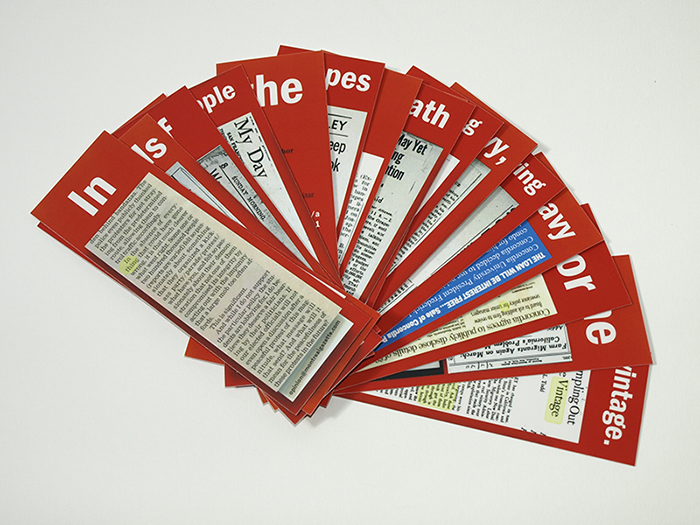
Over a period of four hours, a series of 18 red bookmarks were placed inside books that dealt with ethical investing, government expenditures, on-campus strikes, banking, anti-corruption, and quality management in higher education. Each bookmark carries one word quoted from The Grapes of Wrath: “In the souls of the people the grapes of wrath are growing heavy, growing heavy for the vintage” (Steinbeck, 1939, p. 349), juxtaposed with images from news media. The work could be experienced by serendipitously discovering lone bookmarks or by seeing the post-intervention installation, which offered a reading list that links all 18 bookmarks and reunited Steinbeck’s phrase.
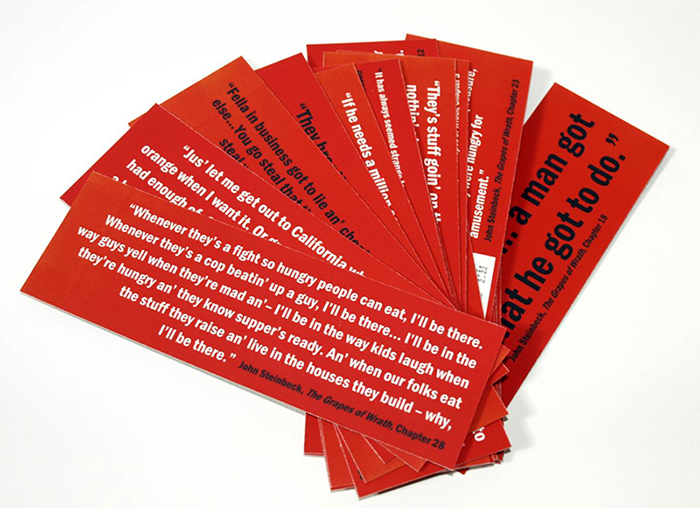
Red Bookmarks was an exploration of institutional critique in the context of the then ongoing student protests in Quebec. The project silently dialogued with the library’s architectural space as a place for gathering and providing a vast world of knowledge, history, and stories. In contrast to the quietness and stillness of the library environment, protests are typically noisy and active. Red Bookmarks acted as an “occupation” within the library as a form of silent manifestation. By placing Steinbeck’s novel against the context of the student strikes and general discontent, I repeatedly thought about how well-intentioned, hard-working students and citizens continue to find themselves in compromised or disenfranchised positions due to poor governance and uncontrollable market forces. As I followed the Joad family to California on their quest to redeem integrity and find work during the 1930’s Dust Bowl Era in Steinbeck’s novel, I realized how industrialized farming shaped their futures. I reflected upon the parallel between the effects of industrialized farming on farmers in the 1930s and the impact the corporatization of universities will have on our society’s future. I felt that by facilitating others to make these links, I could provide an opportunity to build agency through visual conversations. Framing art-making as a way of bringing awareness to civic issues is part of the critical pedagogy which currently guides the collective art making strategies I explore as an art education student and educator.

I documented the intervention and was excited to experience the relational interactions and movement that took place within this space. After the intervention, Red Bookmarks was displayed in the library’s glass display cases. Each glass case displayed six bookmarks, both the front and back, documentation of the intervention, and the project’s textually-based designs which bridge articles from the American Library of Congress, The Montreal Gazette, Concordia campus websites, and The Link with quotes from Steinbeck’s characters. One glass case displayed Steinbeck’s book, the bookmarks and the reading list. To my excitement, after the Webster’s exhibition of the intervention, 14 of 18 bookmarks had been removed from the books, and two books had been checked-out.
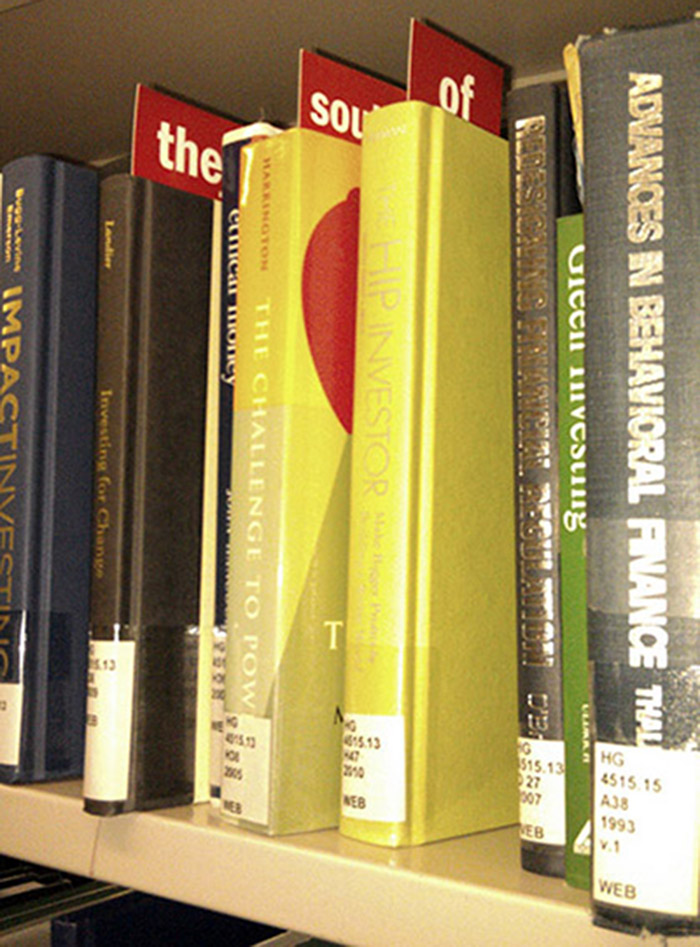
Fragmenting the totality of the laden phrase “In the souls of the people the grapes of wrath are growing heavy, growing heavy for the vintage” and re-contextualizing it within the Library allowed the bookmarks to quietly yet powerfully “occupy” this institution. Sorting through the aesthetic of text and commercial underscores for the viewer that the functional and the familiar always have a message, an agenda, even if we might normally gloss over it. Using words instead of imagery in order to imitate “what books do,” invites the reader to create his/her own mental imagery. Researching current campus politics, how integrity and empathy are possible within the corporate university, and demonstrating how it is the many details (or pieces, or words) that make up the whole, reflect my intention to make socially conscious art. The reading list created throughout this process completes the site-specific role of the Webster Library as an institution where diverse perspectives and voices freely exist to expand thinking.
References
Steinbeck, J. (1939). The grapes of wrath. New York: Viking Press.
Saraid Wilson
3rd Year, Art Education Specialization
One Lesson
One Lesson is a closed social network that relies on the same principles of Facebook to connect community centers and art education students to promote social change through mutual benefaction.
I have established One Lesson in response to my own experiences teaching art at community sites, and seeing the great need in these important venues for art teaching and learning. As a Concordia Art Education undergrad, I am also very aware of our own need for real-world experience teaching art – as well as of all we have to offer. In 2011-12, I worked as the after school care Homework Program Supervisor at Dawson Community Centre, in Verdun. There, the ‘5 to 12 Program’ offers after school care including: homework tutorials, nutrition, physical education, anti-bullying prevention, and the arts. The centre is also a neighbourhood hub that provides parent counselling and social aid. These programs are primarily funded by corporate bursaries and government grants, with some private sponsorship. Budgets for art supplies and materials are significantly smaller than those of most elementary and secondary schools, if any budget exists at all. At Dawson, I could see the need for relief to overworked community organizers and the injection of new fresh ideas for the arts.
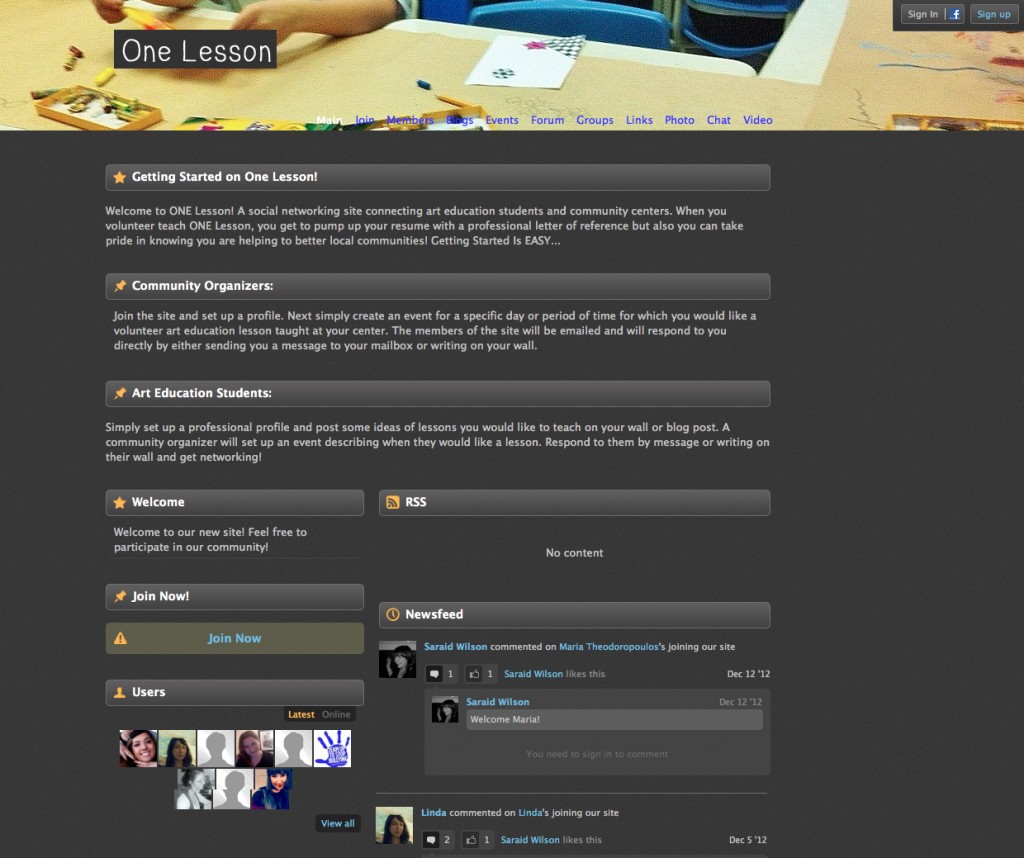
For our part, Concordia University art education students are in a position to provide a service to their community, demonstrate the importance of their discipline – all the while benefitting from practical experience. This reciprocity is the premise behind One Lesson. One Lesson asks Concordia art education students to sign up to the website and volunteer to teach one lesson in exchange for a professional letter of reference from the community centre organizer. Art education students would cover partial or all costs of materials and provide a rich, balanced lesson. All students who join the website must be an approved Art Education Concordia Facebook member for security purposes and can sign into the One Lesson website using their Facebook profile.
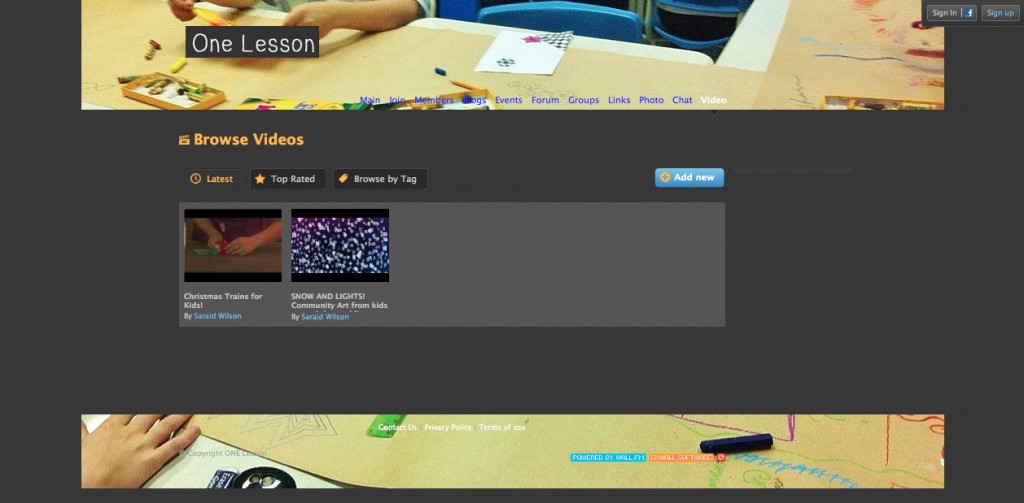
Community centre organizers can join the site and post an `Event’ to which students can reply directly to the organizer with an idea of a lesson that would fit the needs of the community centre’s population and area of focus. While it is still in the development phase, One Lesson will, I believe, allow for the establishment of a new network for art education students, who can gain experience for their professional practice while implementing growth and positive social change to the community, and integrating Concordia University’s Art Education program even more deeply into Montreal communities.
Join One Lesson today at onelesson.wall.fm
Anna Labarias
3rd Year, Art Education Major
Creating Art with Youth in Rwanda
While the children often smiled and sometimes cried on my shoulder, I knew I could never grasp the true extent of their reality. Several of the seemingly well-adjusted youths were failing in school, and I wondered how much of it was due to the challenges of being a teenager, and how much was related to the difficult events they had experienced during the war.
This research paper is a reflection on my experience as a volunteer art educator in Rwanda. I would like to interpret my experience alongside similar initiatives by other researchers. Through awareness of other perspectives and art, I hope to improve my ability to create healing bridges with children, in an intercultural context. According to art therapist Valerie Chu (2010), who worked for five summers in a community centre in Rwanda, cultural differences can be at once an advantage and a challenge, since definitions of sickness, healing, and art can vary from one culture to another. Chu (2010) explains, «…Rwandans often believe that “the tears of a man flow within,” or that deeply felt emotions should remain inside a person rather than be expressed out-ward (p.6).
It is because of these cultural differences that I would like to describe the research that I did before and after visiting Rwanda, in order to understand which art activities were best suited for a Rwandan youth population. My Rwandan experience began with a presentation by a fellow student in my art education course at Concordia University. The presentation documented her experience with a photo literacy project in Haiti, citing several international examples of where this type of project had been successful, including one orphanage in Rwanda. I contacted that same orphanage about volunteering as an art educator, and was accepted to visit over the summer. Between January and July in 2012, I gathered as many ideas for art projects as possible to interest Rwandan youth while considering several challenges. The cultural differences, such as taboos against displaying emotion, sharp gender divisions, emotional scars from the 1994 war, the backlash of colonization, were all factors, as was my being a white woman working within a population of primarily black males. Other challenges included the less than humane treatment of the youth at the orphanage combined with the imminent closure of the orphanage.
Thankfully, my previous experience as a volunteer art educator in Benin in 2006 prepared me for difficult situations and fuelled my enthusiasm for intercultural research. In Romeo Dallaires’ book Shake Hands with the Devil (2005), he cites the important role of education to help prevent violence (p.511). In my research, I sought out to find art education projects in Africa and around the world. One example is Sonya Clark’s Beaded Prayer Project (2003), where hundreds of participants wrote a wish, sewed it to a piece of cloth and included it in a collective mural which travelled throughout Africa, North America and Europe. Another impressive work is the Philadelphia Mural Arts Project, bringing together street kids, local prison inmates, and rehabilitation centre patients to paint hundreds of murals around the city, allotting a space for silenced people to express themselves (muralarts.org). I was also struck by the Montreal Life Stories Project which “is an oral history project exploring Montrealers’ experiences and memories of mass violence and displacement.” (2012, lifestoriesmontreal.ca)
Following this, I found out about Brooklyn Museums’ exhibit “Question Bridge: Black Males” created by artists Hank Willis Thomas and Chris Johnson in collaboration with Bayeté Ross Smith and Kamal Sinclair. The artists used video to invite black men of all ages and origins to respond to each-others questions about identity and history, standing in for an absent father or male role model (Brooklyn Museum, 2012). Also through the Brooklyn Museum, I learned about artist Kehinde Wiley’s painting Officer of the Hussars (2007). It depicts a contemporary black man riding a rearing white horse in the pose taken by Napoleon Bonaparte from Jacques Louis David’s famous series of portraits (1801-05). These works for me seemed to be a good starting point for a discussion with Rwandan youth regarding identity and history. To further expand my research I attended a workshop on natural indigo dyeing, a traditional African technique, with Montreal artist Valerie Walker. Finally, I volunteered for the musical ethnodrama “Our World” at the Concordia Centre for the Arts and Human Development in order to gain some experience in working with adults.
Upon my arrival at the orphanage in Rwanda, I shared with the youth some of my art, and asked for their help in translating poems by Maya Angelou, Mohammed Ali, and Tupac Shakur into the local language of Kinyarwanda. These were displayed in the orphanage dining room. I presented them with art by non-western artists including “Essaouira, Artistes Singuliers”(2002), a catalogue of paintings by self-taught artists from Tunisia, books with symbolic images including tapestries by Jean Lurçat, as well as videos from the Cirque du Soleil. Creating emotional outlets, I gave them my pair of boxing gloves and helped them build a punching ball out of rice bags and sand, set up a volleyball net, and took the youths trekking in the hills, caves and in the nearby countryside. I regularly participated in peeling potatoes, washing dishes, and doing laundry – activities they had never seen a white person take on. These activities helped us to get to know each other and created a sense of trust. Through this participation I was able to convey that I wasn’t there as an authority figure, but as a facilitator.
The activities were organized collectively, incorporating suggestions by the youths and myself. I made some mistakes when trying to communicate my ideas with the group, but luckily the youths helped me to correct them. My strategy was to create open communication, drawing on Freire’s idea of “dialogical education” (p. 56-57), which fit well within Rwandan community-based culture (Freire, 2005). I rarely took pictures of the children’s work myself, but instead lent them my camera to photograph what was most meaningful to them. Many of the projects that I proposed including natural indigo tie dying, reproducing Sonya Clark’s Beaded Prayer Project, did not at all speak to the youths and were unsuccessful. The girls were not interested in making the tiny dolls, which I so enjoyed making myself, and time constraints and age appropriate complexities did not allow us to finish the two meter high, giant puppet project.
However, there were some pleasant surprises. Life drawing appealed to youths of all ages and beadwork was a success among the boys. Despite my lack of knowledge in video software, the youths were also able to create a video about their life experiences using my computer. Another project was an idea that came from one of the boys: to interview the original manager of the orphanage, who had acted as a father and a male role model to the youths until his retirement. Using my computer, the youths visited him and created a video of their interview. The youths set up a collective screening of the video for everyone in the community to see. As many of the children had not seen their own father in years, it provided an important example of a male role model.
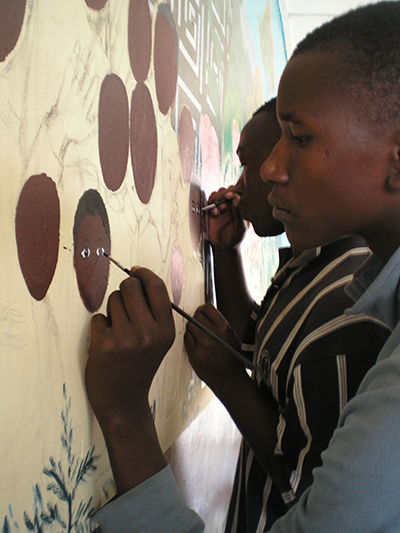
Perhaps the most effective of the activities was the painting of a mural. One of the boys came up with a design which really spoke to all: a mural representing Roz Carr, the much-loved founder of the orphanage, surrounded by all the youths. Visually, the result was beautiful. However we encountered some problems in participation. Certain dynamics within the youths came to light with a group of artistically talented boys taking over, keeping other children, especially the girls, at bay. As a response, we expanded the mural to four walls instead of one, in order to allow for greater participation. The social dynamics were again raised into question when some of the youths asked me to paint the figure of the founder, over the work of less artistically skilled youths. Through some discussion we agreed none of the work would be erased.
Due to the critical environment of the youths within the orphanage, none of the participants wanted to risk painting the central figure, in fear of being made fun of. I gave in to their requests and undertook this task and bore the brunt of the jokes until I achieved a result that was satisfactory to most. In retrospect, I could have resisted their request and insisted that the children complete the mural themselves. However, after two months of living in Rwanda under difficult conditions, I did not wish to engage in any form of confrontation.
Professor Irene Gericke, in the Department of Creative Arts Therapy at Concordia University, suggested to me that the ideal closure for the mural activity would have been to have the youth photograph themselves with the mural. It turned out that in fact the youths on their own had taken hundreds of pictures of each other with the mural. I realized that photography allowed those who did not participate in the painting of the mural to become part of the work. This project turned out to have particular poignant significance to them since the orphanage is in the process of closing and the youths who have grown up together are being separated, many to live on their own in difficult conditions. To celebrate the completion of the mural, we organized a pasta dinner, the youths favourite meal.
While the youths often smiled and sometimes cried on my shoulder, I knew I could never grasp the true extent of their reality. Several of the seemingly well-adjusted youths were failing in school, and I wondered how much of it was due to the challenges of being a teenager, and how much was related to the difficult events they had experienced during the war. According to National Institute for Mental Health, post-traumatic stress disorder (PTSD) involves re-experiencing symptoms related to the event, avoiding reminders of the event, and being constantly “on edge” (NIMH, 2012, p.2). Caroline Beauregard, an art therapist whose research interests are strongly influenced by humanitarian experience in Rwanda, including trauma and art therapy interventions with children who have been exposed to armed conflict; states that PTSD is a western definition therefore this problem can be named and expressed differently in other cultures. In Uganda it is defined as “Cen,” meaning “an angry presence”; while in Liberia it is defined as “kazumbi,” meaning evil spirits (Beauregard, 2010, p. 31-32).
In addition, Beauregard states that children may not express their trouble in the same ways as adults, but rather in the form of play (Beauregard, 2010, p.32). Each culture has a different approach to healing. In traditional Kenya for example, women collectively help each other to rebuild their houses. This involves mural painting, which allows for a creative healing experience (Akinyi Wadende, 2011, p. 66). In Uganda, traditional healers are involved in today’s rehabilitation programs for child soldiers (Beauregard, 2010, p. 27).
From a western perspective, the stages toward healing include telling one’s story, mourning, commemorating, and creating new connections. Definitions of art and healing are different from one country to another. Art therapy is helpful when a culture does not allow for verbal expression of difficult experiences (Chu, 2010, p. 5). “In some cultures, expressing emotion is a sign of immaturity and thus a child might prefer copying a drawing than creating his own design” (Malchiodi, as cited by Beauregard, 2010, p. 35). However, when proposing art activities, it is necessary to use symbols that are specific to a person’s culture (Beauregard, 2010 p. 34) so that the individual may get in touch with the difficult aspects of their experience. Through art, a person can reflect on experiences otherwise too painful to be expressed. By externalizing experience through art, one can gain a sense of control over once overwhelming experiences. When an individual gains mastery over experiences by putting them into a story, they can regain a sense of self and open up to life again (Chu, 2010, p. 9).
According to Blum (2010), important aspects of an art therapist’s work in an intercultural environment include getting to know and building trust within the community (Blum, 2010 p. 13). An art therapist may then focus on the child’s “islands of competence” (Blum, 2010 p. 13). Based on her work with street kids in Rwanda, Beauregard states the need to provide children with a stable, constant environment, to discuss rules and confidentiality, and to include opening and closure rituals, such as dancing and singing in art activities. Beauregard also suggests alternating projects that touch on past trauma with projects focused on resilience (Beauregard, 2010, p. 38), including collective activities such as a mandala activity which combines storytelling and art.
To further my research I have found other works that perpetuate the theme of collective healing. In her thesis on the treatment of war-affected children, Michelle Bobich (2011, p.105) recognizes that art therapy, especially music and dance, can play a role in recovery. Gabrielle Daoust (2010), who studied the role of community theatre in Rwanda, states that by allowing the expression of criticism towards the government and other sources of injustice, theatre can help heal not only the individual, but also the community (p. 65). Kay Heley (2010), in her M.A. thesis from the Centre for Global and International Studies at Kansas University, explains the grounding experience provided by drumming among youths growing up in post-war Liberia (p. 77). Professor Annette Blum at the Ontario School of Art and Design describes the impact of making memory boxes, body maps, and embroidered memory cloths for women affected by poverty and AIDS in South Africa (2010, p. 13).
Although art therapy is considered to be a western idea, healing through arts has existed for a long time among many cultures through chanting, dance, music, theatre, body arts, among others. In addition, I believe in the words of postcolonial theorist Edward Said (1978), who asserted that we do not exist in opposition to the ‘other’ but in continuity, and that this ‘other’ is not a passive recipient of western influences, but a person who is active, creative and critical (p. 118). Western society does not have the monopoly on healing through art and is not so powerful that its ideologies supersede or erase other ways of seeing the world.
While there seems to be many creative approaches to help youths, every youth is unique and there is no magic recipe to address one single problem. Everyone follows a different path and no amount of knowledge can replace having sensitivity to other people’s needs. I believe that self-awareness as described by Freire (2005, p. 90-91) is essential, and that being willing to dive into someone’s world is key to realizing our similarities rather than our differences. This includes labelling a person with their disease, instead of recognizing them as a human being. By understanding the steps towards recovery, one can design activities adapted to a specific culture while addressing the needs of the individual, without being confined to a rigid program.
In conclusion, I have learned that storytelling is an important aspect of recovery and that incorporating digital technology, which was very popular among Rwandan youths, into art activities is essential. Developing a positive notion of ‘the other’, building of a sense of self and defining one’s identity is important for all but especially for those recovering from an experience of war. My research has led to one dominant conclusion that can be summed up in the following quote by Orbinski, the founder of Doctors without Borders (as quoted in Kim Ping Yim, 2012):
“Too often, we see the suffering of others as somehow separate from ourselves; and we chose to take pity on those who suffer, and sometimes we can choose to take action to relieve that suffering. However, when one literally sees the other is equal in worth and dignity, when one literally sees them as one sees oneself, then compassion lead not to pity but to solidarity… (p.48)”
References
Akinyi Wadende, P. (2011). Chuech manimba: Indigenous creative education among the women of the Luo community of western Kenya. 66.
Blum, A. (2010). Private memory, public truths: Voices of women and visual narratives in post-apartheid Africa. International Journal of the Arts in Society, Volume 5, Issue 6, 13.
Beauregard, C. (2010). Panser les blessures de guerre: Le potentiel de l’art-thérapie auprès des enfants-soldats démobilisés. University of Montreal; Montreal, Quebec. 27, 31-32, 34-35, 38.
Bobich, M. (2011). War affected children & treatment intervention: A comprehensive literature review. Azusa Pacific University; Whittier, California. 105.
Brooklyn Museum. (2004). Exhibitions: passing/posing: Kehinde Wiley paintings. Retrieved from: www.brooklynmuseum.org
Brooklyn Museum. (2012). Exhibitions: question bridge: black males. Retrieved from: www.brooklynmuseum.org
Chu, V. (2010). Within the box: Cross-cultural art therapy with survivors of the Rwanda genocide. Art Therapy: Journal of the American Art Therapy Association, 27(1), 5, 9.
Clark, S. (2003) Beaded prayers. Retrieved from: http://sonyaclark.com
Concordia University Centre for the Arts in Human Development. (2012). Our world: A musical ethnodrama. Retrieved from: http://cahd.concordia.ca
Dallaire, R. (2003). Shake hands with the devil: The failure of humanity in Rwanda. Random Housa Canada. p.511.
Daoust, G. (2010). “First, we act it”: Community theatre & reconciliation in post-genocide Rwanda. 65.
David, Jaques- Louis. (1801-1802). Napoleon crossing the Saint Bernhard Pass. Oil on canvas. 246 x 321 cm. One of five versions (1801-1805). Chateau de Versailles (Versailles, France).
Essaouira Artistes Singuliers, Editée par la Galerie d’Art Frédéric Damgaard, 2002. Retrieved from: www.africultures.com
Freire, P. (2005). Teachers as cultural workers: Letters to those who dare teach. Westview Press; Cambridge, Massachusetts. 56-57, 90-91.
Heley, K. (2010). Cultural acts: Gateway to healing for urban youth in post-conflict Liberia. 77.
Life Stories Montreal (2012). Rwanda working group. Retrieved from: www.lifestoriesmontreal.ca
Philadelphia Mural Arts Project (2012). Mural arts program. Retrieved from: http://muralarts.org.
National Institute of Mental Health (2012). Post-traumatic stress disorder. p.2. Retrieved from: www.nimh.nih.gov
Said, E. (1978). Orientalism. US: Vintage Books, p.118.
Wiley, Kihinde. Officer of the Hussars. 2007. Oil and enamel on canvas. Detroit Institute of Art, Detroit, USA. Retrieved from: www.brooklynmuseum.org.
Yim, K. (2012). Humanitarian Visual Culture Curriculum : An Action Research Study. Ohio State University; Columbus, Ohio. 48
Lauren Costello
3rd Year, Art Education Specialization
Map of Kindness Artspiration
My internship experiences have taught me that typical holiday art lessons need to be re-evaluated. Too many educators fall into the cookie cutter craft routines during the holidays, leaving creativity and critical thinking behind. Thus, I wanted to produce a unit plan that would suit any age group and could be introduced during the holidays without falling into the traditional holiday craft approach.
This unit plan is designed to provoke students to be aware of their surroundings, their community and the ways we function within it. This unit plan encourages students to consider how individuals can make a difference and enrich their community through simple acts of kindness.
Rationale
This unit plan fosters critical thinking and examination of social issues. Participants will initiate acts of kindness to recipients. During this process, students will learn to document their acts of kindness using a photo-sharing website. This will reinforce how small gestures can spread happiness and help others.
Lesson Plan Description and Objectives
Designed for cycle two high school art classes, this unit plan asks students to document different acts of kindness using Panoramio, a free online photo sharing website. Each week, students will discover a new artist and learn a different art technique. During each weekly session students will explore a new technique and create an individual work of art. Students will give their work of art to someone meaningful to them. The act will be photographed and documented on Panoramio, using the visual map network features on the website. Students will also be encouraged to create a digital art work using web-based programs and email it to someone they may not be able to reach on foot.
Procedure:
Visual Art Competencies
Competency 1: To produce individual works in the visual arts.
Cross-Curricular Competencies
To use information: Works of the chosen artists will inspire students to develop their own ideas using similar artistic approaches. Communicating appropriately: Students will think critically about their artworks to express their feelings appropriately towards the recipient.
Questions of Inquiry
Vocabulary
Featured Artists
Materials
Educator Materials:
Student Materials:
Assessment
Evaluation of the unit plan and individual lessons will be based a on a rubric using the “Framework for the Evaluation of Learning” by the QEP (MELS, 2011). In addition, students will be encouraged to continue their acts of kindness and document them on their map, to which a participation grade will be attribute at the end of the term.
References
Ministère Éducation, Loisir et Sports du Québec (2011). Frameworks for the evaluation of learning: Timetable for Preschool Education and Elementary School. Downloaded from: www.mel.gouv.qc.ca Panoramio (2013). Panoramio. www.panoramio.com
Myriam Vincent
3rd Year, Art Education Specialization
Yarn Bombing: From Personal Practice to the Classroom
I believe this collective experience was a success because not only did it give the students an insight on public art and contemporary participatory practices, but it also created a sense of pride and group accomplishment.
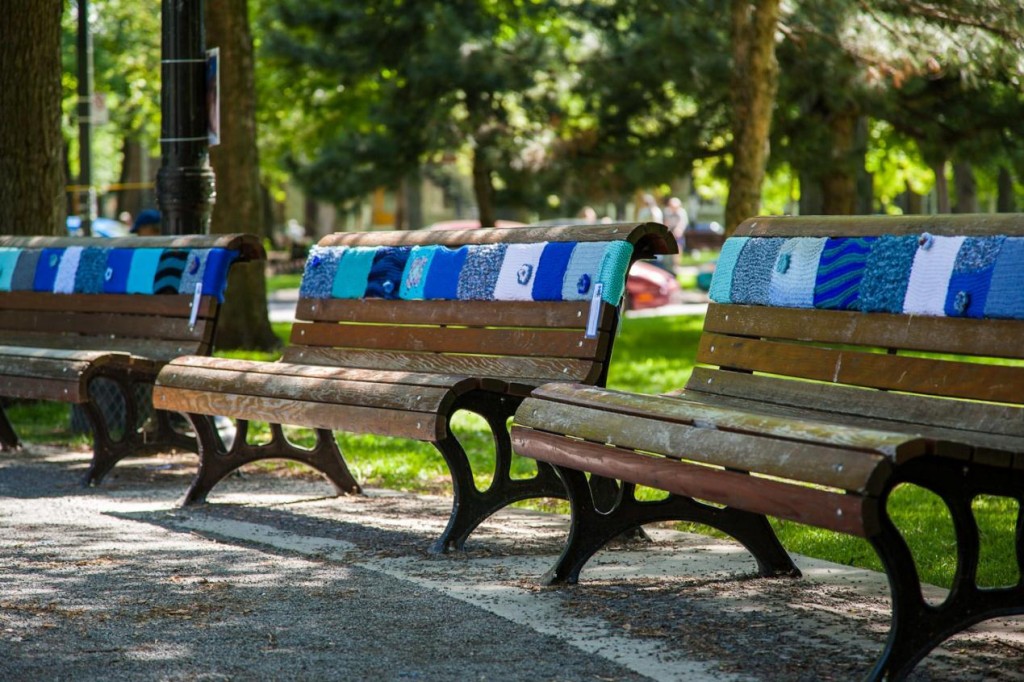
As an artist and crocheter, I was involved in creating a collective yarn bombing installation that took place at Molson Park in Montreal on the International Yarn Bombing Day on June 9, 2012. A collective was formed with members being family, knitters and artists. Together, we had the idea of using yarn bombing as a mean to raise public awareness about autism, autism spectrum disorders and the importance of research. Our goal was to adorn several benches in the park with blue scarves, blue being the color associated with autism awareness.
Six benches were ‘bombed’, creating a soft and colorful backdrop in the park. Molson Park is a lively neighborhood spot in Rosemont, where people have picnics, play bocce ball with friends, walk their dogs or play music. It was an ideal setting for our installation. Each scarf was composed of twelve rectangles knitted or crocheted by members of the collective, using different yarns and shades of blue. Members were encouraged to be creative, which resulted in added flowers and other decorative elements to their pieces.
We added a laminated tag that had a link to the Autism Speaks website (www.autusmspeaks.ca), reinforcing our objective of raising awareness and emphasizing the importance of research. We saw many people taking the time to read and engage with the piece during the week before being the piece was removed, taken or lost – a reality of public art installations.
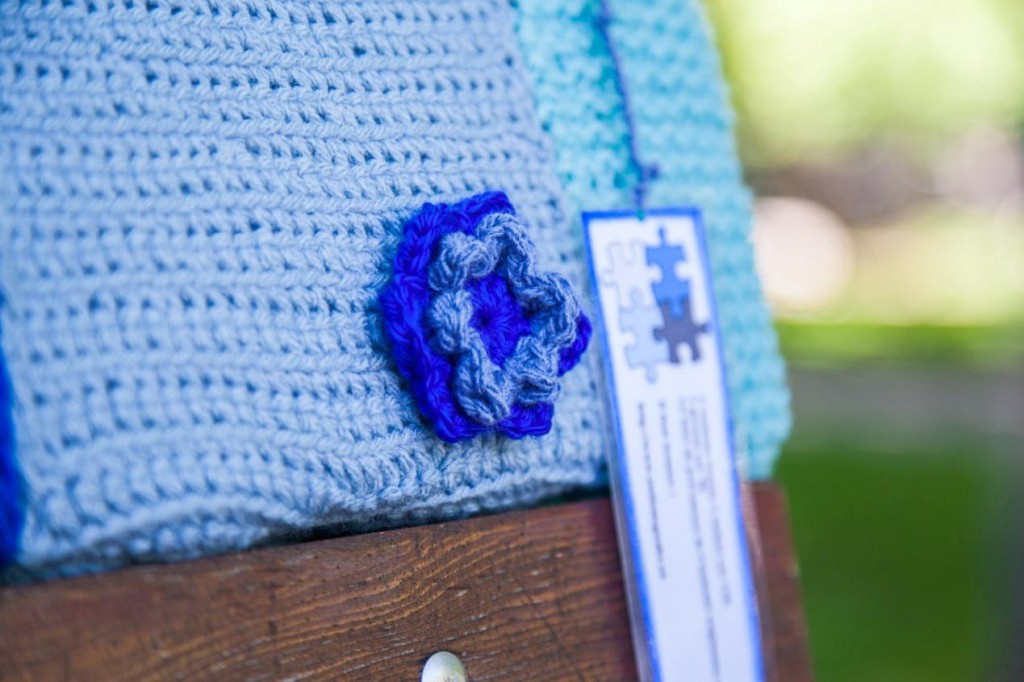
Building on this successful personal experience, I challenged myself to share this undertaking in my internship at Vanguard Elementary School. A class of twelve students, aged between 11 and 13 years of age participated in the project. Like the members of the collective, each student crocheted an individual rectangle. Learners used the cardboard weaving technique, and assembled the pieces first in pairs, than in groups, to form a long collective scarf that was later installed on a tree. The installed piece overlooks the schoolyard and is part of the student’s everyday life.
I believe this collective experience was a success because not only did it give the students an insight on public art and contemporary participatory practices, but it also created a sense of pride and group accomplishment. With plans for relocating the school, teachers intend to use the piece as part of a transitional event, by bringing it to the new school as a colorful reminder of their old school and the time that was spent there.
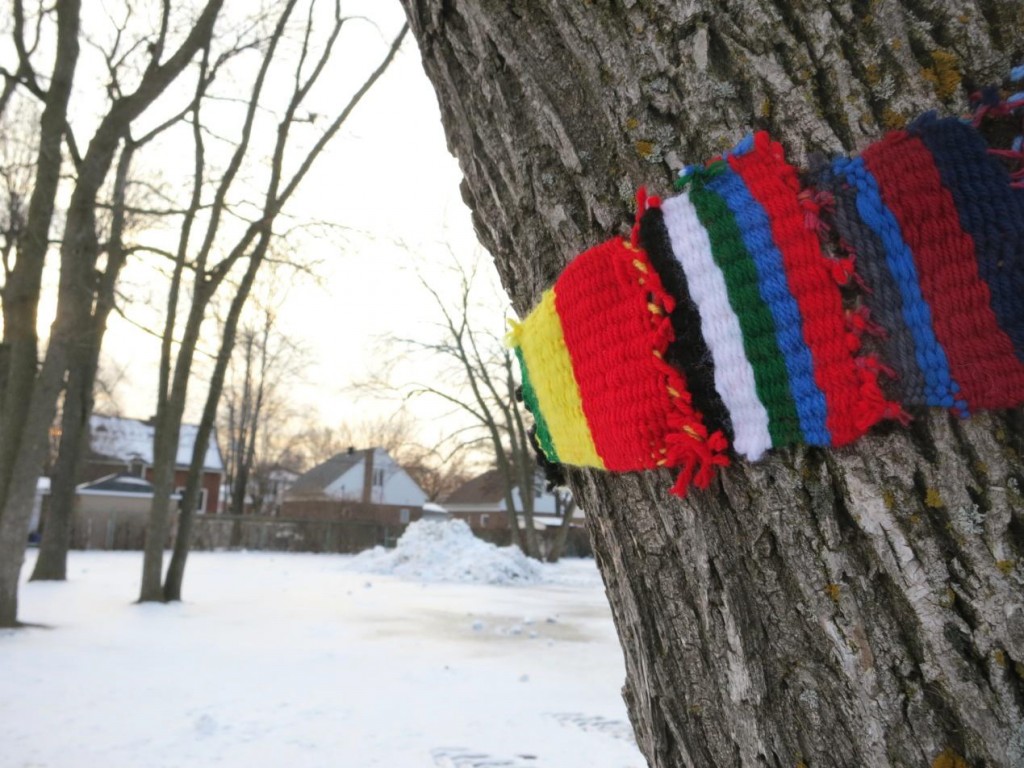
On Yarn Bombing
Yarn bombing is an easy, inexpensive, fun and non-destructive means of expression that offers the possibility to explore fiber art, the history of crafts, as well as providing a way to engage students and artists in craftivism (craft+ activism) which are practices that are concerned with social awareness and change.
References
Artists and educators interested in yarn bombing should consult this great resource for more information:
Moore, M. & Prain, L. (2009). Yarn bombing: The art of crochet and knit graffiti. Vancouver: Arsenal Pulp Press.
For more information and instructions about cardboard weaving, please consult the following resource:
Ellenberger, J. (2012). How to weave on a cardboard loom. www.instructables.com
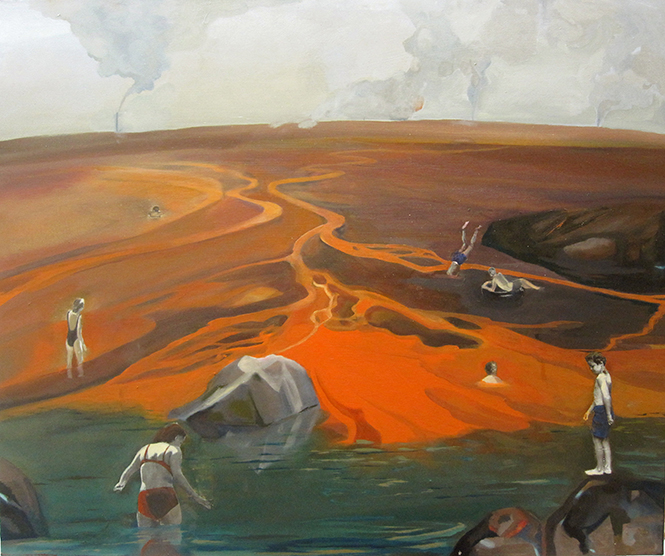
Linda Luttinger
4th Year, Art Education Specialization
Tailings Beach
oil paint and collage on canvas
36” x 36”
2012
In Tailings Beach two contradictory realities are juxtaposed: the benign enjoyment of swimming in lakes, rivers, and beaches and the horror of our increasingly toxic waters, desecrated by oil extraction and pollution. The “ tailings” of the title are mining industry waste like those produced by the Tar Sands in Alberta, one of the largest oil extraction projects in North America. The project is continuing to expand, despite great protest.
The painting aims to create a paradox, a shock as the viewer tries to understand why the figures in the painting are bathing in toxic water. Wrestling with this conundrum, the viewer is encouraged towards a critical consideration of our society’s environmental obliviousness. From an art education perspective, this painting represents the importance of teaching about environmental justice, global warming, and the politics of the oil industry. I strongly believe that becoming aware of our changing environment is crucial, and should be reinforced in educational practice.
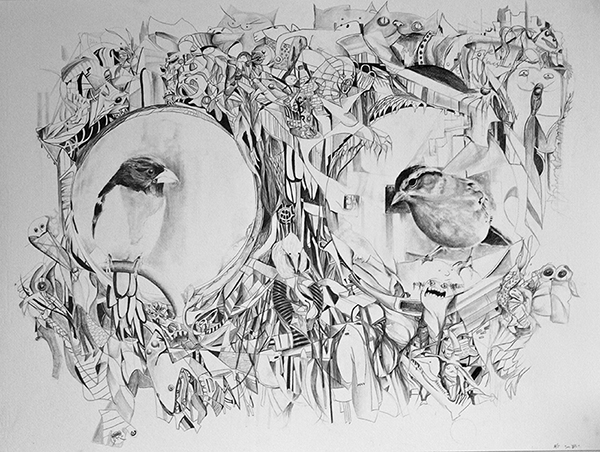
Michael Gauthier
5th Year, Art Education Specialization
Reflect
graphite on paper
22” x 30”
2012-2013
This surrealist work demonstrates a progression of my technical exploration. It is a collection of spontaneously drawn creatures, etched over the span of 8 months. Time was a factor in this process, as well as gestalt images emerging from automatic lines. The work summarizes various events in my life, involving my practices as artist and educator. Reflect depicts a struggle to combine theory with practice, one that I believe is present in the process of becoming an art educator. I believe the exploration of both traditional and contemporary forms of art in the classroom allows students to express the social, political, and cultural ideas that they might otherwise struggle to convey. My own understanding of these issues has grown in tandem with my personal practice. My artistic endeavours have driven me to explore other cultures and have subsequently given me an awareness of social justice issues of which I was not aware. As an art educator, I strive to inspire students to view artistic practice as a means to explore the larger social and political frameworks that surround them in their everyday life.